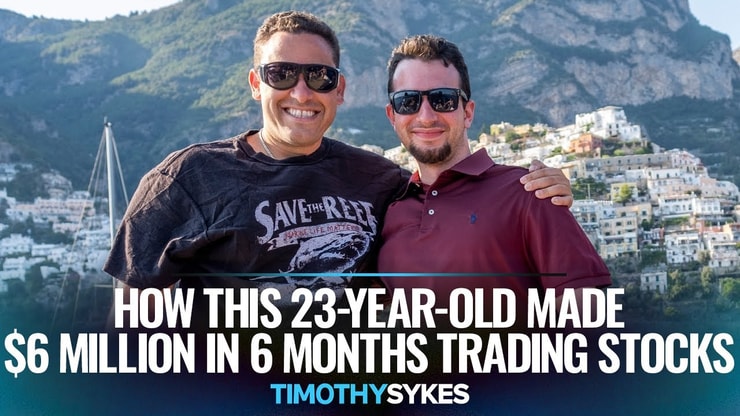Short squeeze stocks are the Porsches in the race course of trading, creating excitement and potential opportunities for traders. These stocks are among the most traded stocks on the Nasdaq. In penny stock world, the amount of money generated for short squeeze reasons is incomparable.
But what exactly are short squeeze stocks?
A short squeeze occurs when a heavily shorted stock experiences a sudden surge in buying pressure, leading to a rapid and significant increase in its share price. This phenomenon can cause short sellers, who initially bet on the stock’s decline, to scramble to cover their positions, resulting in further upward pressure on the stock price.
In this article, we’ll cover the purposes of short squeeze stocks, why someone would be on the other end of a short squeeze, and how short squeeze gains can rack up faster than the interest on credit cards! Let’s get to it.
Table of Contents
Definition of Short Squeeze Stocks

2025 Millionaire Media, LLCShort squeeze stocks are characterized by a unique interplay between buyers and sellers in the market. When traders short sell a stock, they borrow shares from a broker and sell them, anticipating a price decline. However, if the stock starts to rise instead, short sellers find themselves in a precarious position. To limit potential losses, they need to buy back the borrowed shares and return them to the broker. This buying activity, coupled with increasing demand from other investors, can trigger a short squeeze.
The occurrence of a short squeeze is driven by several factors, including the number of shares sold short, the stock’s daily trading volume, and the overall interest from investors. Short squeeze stocks often garner attention due to their potential for large and rapid price movements.
So… what happens when you’re on the other side? Short selling is a strategy that can be profitable when done right — though so many do it wrong.
If you’re a short seller, PLEASE BE SAFE.
DO NOT SHORT SELL until you educate yourself. Your first step? This guide on how to short sell stocks. It provides valuable insights into the process and how to mitigate the tremendous risks.
Why Invest in Short Squeeze Stocks?
Trading short squeeze stocks can offer unique opportunities for traders seeking high returns. When a short squeeze occurs, the stock price can experience a sharp and sudden increase, potentially leading to significant profits for those who are positioned correctly.
The daily trading volume of a stock plays a crucial role in determining its susceptibility to a short squeeze. When a heavily shorted stock witnesses a surge in buying pressure, a low trading volume can amplify the impact, as it becomes more difficult for short sellers to find available shares to cover their positions. This scarcity can intensify the buying pressure and drive the stock price higher.
Impact on Market Prices
Short squeeze stocks can have a broader impact on market prices. The sudden surge in buying pressure not only affects the specific stock experiencing the short squeeze but can also influence market sentiment and trigger increased demand for other stocks. This phenomenon can create a ripple effect, leading to heightened market volatility and potential opportunities for traders to capitalize on momentum and price fluctuations.
More Breaking News
- Quantum Leap Forward: QBTS Stock Dynamics
- Webull Corporation’s Stock Skyrockets: What’s Driving the Surge?
- Lucid Group Strengthens EV Supply Chain with New Graphite Deal
The number of outstanding shares plays a significant role in short squeezes. If a heavily shorted stock has a relatively small number of outstanding shares, it becomes easier for buying pressure to overwhelm the supply of available shares. As short sellers rush to cover their positions, the limited number of shares in circulation can result in a rapid increase in the stock’s share price.
One of the defining characteristics of short squeeze stocks is the sharp and sudden increase in share price. When a short squeeze occurs, the buying pressure can create a frenzied atmosphere, with investors scrambling to buy shares at any price. This buying frenzy drives the share price higher, often surpassing what fundamental analysis would deem reasonable in the short term.
Rapid Rise in Investment Strategy
Short squeezes can lead to a shift in investment strategies. Traders who initially planned to short a stock may shift their focus to buying and holding shares to take advantage of the upward momentum. This change in strategy can further contribute to the upward pressure on the stock’s share price, as increased buying activity continues to outpace the ability of short sellers to cover their positions.
Financial Crisis and Financial Markets

2025 Millionaire Media, LLCDuring times of financial crisis or heightened market volatility, short squeezes can become more prevalent. The combination of increased market uncertainty, significant price fluctuations, and amplified investor emotions can create an environment ripe for short squeezes to occur. It’s crucial for traders to understand the dynamics of short squeezes and how they can impact their investment decisions during these periods.
Understanding the Current Market Price
When considering short squeeze stocks, it’s essential to evaluate the current market price and its potential for a squeeze. A stock that has experienced a prolonged period of decline and exhibits strong short interest may have a higher likelihood of a short squeeze. Conducting thorough research, analyzing market data, and monitoring the sentiment surrounding the stock are vital steps in assessing the potential for a short squeeze.
3 Short Squeeze Stocks to Consider
While short squeezes can be unpredictable and challenging to time accurately, there have been notable instances of short squeezes in the past.
Stocks like GameStop, AMC Entertainment, and BlackBerry are prominent examples where a surge in buying pressure caused significant short squeezes, resulting in remarkable price increases.
Past performance does not guarantee future results. But studying historical examples can provide valuable insights and potential trading opportunities.
The more you learn about trading, the better you’ll become at spotting new trading opportunities. That’s exactly why I’m always looking at penny stocks.
Just like short squeeze stocks, trading penny stocks requires a solid understanding of the market and a well-thought-out strategy. To enhance your knowledge in this area, check out this comprehensive guide on penny stocks. It provides insights into how penny stocks work, how to trade them, and how to mitigate the associated risks.
Valuable Companies for Buy-and-Hold Investors
For buy-and-hold investors seeking long-term value, short squeeze stocks may not align with their investment strategy. These investors typically focus on companies with solid fundamentals, sustainable growth rates, and strong market positions. While short squeezes can generate substantial short-term returns, they often come with heightened volatility and increased risk. Long-term investors are better served by identifying valuable companies that align with their investment goals and maintaining a disciplined approach to their portfolio.
Benefits of Retail Investors
Short squeezes have highlighted the increased influence of retail investors in the stock market. The ability for individual traders to communicate and coordinate through social media platforms, such as Reddit or Twitter, has allowed them to collectively challenge institutional investors and impact stock prices. This newfound power has provided retail investors with a platform to express their opinions, share investment ideas, and potentially participate in short squeezes alongside institutional investors.
How Does a Short Squeeze Work?

2025 Millionaire Media, LLCTo understand how a short squeeze works, it’s essential to grasp the mechanics behind short selling. Short selling involves borrowing shares from a broker and selling them on the market, with the intention of buying them back at a lower price to return them to the broker. In a short squeeze, when the stock price starts to rise, short sellers are forced to buy back the shares at higher prices to cover their positions, contributing to further upward pressure on the stock price.
Why Short Squeezes Happen
Short squeezes happen due to a combination of factors. A heavily shorted stock, increased buying pressure, limited supply of available shares, and short sellers rushing to cover their positions create a perfect storm for a short squeeze. Market sentiment, news catalysts, and coordinated buying efforts from retail investors can also contribute to the conditions that lead to a short squeeze.
Anticipating a Short Squeeze
Anticipating a short squeeze can be challenging, as it requires assessing various factors and market dynamics. Monitoring short interest, analyzing trading volume, studying market sentiment, and identifying potential catalysts are some of the approaches traders use to anticipate a short squeeze. However, it’s important to note that short squeezes are unpredictable and can catch even seasoned traders off guard.
Short squeezes have a lot in common with the biggest movers on the market — they’re often one and the same. These stocks can turn a modest investment into a sizable return due to their dynamic nature. However, trading them effectively requires understanding market trends, earnings reports, and other relevant news that could impact these stocks.
To help you navigate this terrain, check out my guide to hot stocks. It offers a strategic approach to uncovering the most tradable stocks on the market.
Tips for Trading a Short Squeeze
Trading a short squeeze requires careful planning and risk management. Here are some tips to consider:
- Thoroughly research the stock: Understand the company, its fundamentals, and any potential catalysts that could trigger a short squeeze.
- Identify the key players: Monitor the short interest, institutional ownership, and retail investor sentiment surrounding the stock. This information can provide insights into the potential for a short squeeze.
- Set clear entry and exit points: Define your trading strategy and establish specific entry and exit points to manage risk and protect profits.
- Utilize technical analysis: Incorporate technical indicators and chart patterns to identify potential price trends and entry/exit signals.
- Stay informed: Keep up with market news, social media chatter, and relevant catalysts that could impact the stock’s short squeeze potential.
- Manage risk: Implement proper risk management techniques, such as setting stop-loss orders and position sizing, to mitigate potential losses in case the short squeeze doesn’t materialize as expected.
- Stay flexible: Short squeezes can be unpredictable and volatile. Be prepared to adjust your trading plan and adapt to changing market conditions.
Key Takeaways

2025 Millionaire Media, LLCShort squeeze stocks can present exciting opportunities for traders, but they also come with risks and uncertainties. Understanding the mechanics and factors behind short squeezes, conducting thorough research, and implementing effective risk management strategies are crucial for navigating this unique market phenomenon. Traders must stay informed, adapt to changing conditions, and approach short squeeze stocks with a disciplined and well-thought-out trading plan.
Trading isn’t rocket science. It’s a skill you build and work on like any other. Trading has changed my life, and I think this way of life should be open to more people…
I’ve built my Trading Challenge to pass on the things I had to learn for myself. It’s the kind of community that I wish I had when I was starting out.
We don’t accept everyone. If you’re up for the challenge — I want to hear from you.
Apply to the Trading Challenge here.
Trading is a battlefield. The more knowledge you have, the better prepared you’ll be.
Have you ever traded a short squeeze? Let me know in the comments — I love hearing from my readers!










Leave a reply